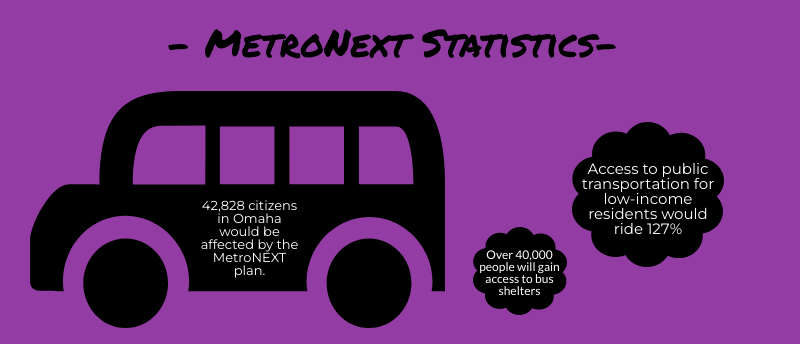A needed development
New Metro plan will create a huge improvement in public transportation in Omaha
Infographic by Alexis Bahensky
The MetroNEXT program will allow for more opportunities to arise in lower-income parts of the city, while also benefiting all classes.
April 27, 2022
Public transportation in Omaha is finally making a big step to ensure all their citizens have reliable facilities to get them to and from their daily activities. However, there is still much more to be done if our city wants to allow for more equality in transportation, and it is our duty as citizens to ensure that these changes are made to our community.
Metro has decided to expand the transit system to ensure equality and to improve the overall system in the Omaha metro area. This plan will be a new part of the MetroNEXT plan, which has a goal of goal is to increase accessibility to public transportation. The plan will take around eight years to be accomplished with a planned deadline in early 2030. More services on the weekend and in the evenings, permanent funding for the K-12 Rides Free program (a program that allows students in certain areas to have free transportation to school if a school bus can’t be afforded), an expansion to Eppley Airfield and much more will be added to the public transportation system. This plan has so many agenda items that will benefit our community, that if not acted upon, could cause more problems for those who rely on those programs and services, especially lower-income families. It is imperative that this proposed development is seen through until the end and prioritized in our community.
It is true that most households own a car with around 33.5% of American households containing at least one motor vehicle, with others containing more. While this may create the illusion that people are able to get around on their own, over 9% of Americans don’t have access to their own forms of transportation and rely on public transportation instead. It may not seem like a lot of people are affected; however, when compared to Omaha’s population of 475,862 people, an estimated total of 42,828 citizens are affected. Most of that population comes from low-income households who rely on transportation services provided by the area they live in. If there are insufficient methods of public transit where they live, their lifestyles will suffer creating more of a reason to expand Omaha’s resources and methods of public transportation.
With the new development of MetroNEXT, an estimated number of over 40,000 people are going to get access to more bus shelters, which act as safeguards from the weather for those waiting at a bus stop. The Omaha World-Herald stated that this will also create an increase of over 127% for access to low-income residents, doubling connection to essential services near frequent routes, while also allowing a 54% increase in job availability within a 30-minute commute. More transportation routes mean more job opportunities. More job opportunities mean more income and more income means better lifestyles. These lower-income citizens will finally gain the opportunities that would be denied to them without the help of public transit.
It is defendable that there are other modes of transportation, such as walking, riding a bike, catching a ride from a friend or family member and more; however, while many of these are useful, they prove to be ineffective compared to the usage of public transportation. Weather is a large factor as, especially in Omaha, it is very unpredictable. Walking or riding something with little to no protection from the elements in extreme weather is risky. It can cause an increase in sickness, fatigue and many other physical complications.
While public transportation protects against the weather, COVID caused curious problems for these systems back in 2020. With the fear of contracting the virus, many services shut down leaving transit ridership to drop by 79%. Affordability also forced people to search for other means of transportation, especially with the number of layoffs that happened within that short period of time. To solve this, Omaha decided to implement the Omaha Rapid Bus Transit, also known as ORBT, by allowing for more routes and a free fare to increase usage. This proved effective for a short time; however, the implementation of MetroNEXT would increase public transit usage even further, leading to more equality for lower-income households.
The amount of impact the MetroNEXT plan will have on lower-income communities is huge. Not only will more access come about, but so will more opportunities to get above the poverty line enough to live comfortable lifestyles. While it is up to our city council to set the plan into action and come up with the details, it is our job as citizens to ensure that the proper funding goes into these projects. Without proper funding, we will receive what is called poor transportation. These are underdeveloped transit systems that rather than allowing for more effective transportation systems, lead to more breakdowns and complications proving to hold the opposite effect. To avoid this, we need to fund it properly.
People are going to be hesitant, most likely using the excuse that the system will have little effect on them; however, this isn’t the case. According to the American Public Transportation Association (APTA), one of the benefits is the easing of the congestion of traffic. So, you’re not only helping low-income families, but you’re also helping yourself as well, especially when it comes to getting to that important event on time.
Before anything else, our public transportation system must be taken into account and put into motion before any other developments can take place. Our city has been moving forward and it would be a shame to see it move backward in development if the plan isn’t carried out12dx or funded correctly to ensure more equality between classes in our city.







